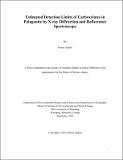Estimated Detection Limits of Carboxylates in Palagonite by X-ray Diffraction and Reflectance Spectroscopy
Metadata
Show full item recordAuthor
Applin, Daniel
Date
2023-09Citation
Applin, Daniel. Estimated Detection Limits of Carboxylates in Palagonite by X-ray Diffraction and Reflectance Spectroscopy; A Thesis submitted to the Faculty of Graduate Studies in partial fulfilment of the requirements for the ... Master of Science in Environmental and Social Change. Winnipeg, Manitoba, Canada: The University of Winnipeg, September, 2023. DOI: 10.36939/ir.202312071601.
Abstract
Low molecular weight carboxylates (carbonates, oxalates, formates, and acetates) are either known or are expected to be present on the surface of Mars. Previous work has suggested these phases to be present in Gale Crater materials at nearly the expected detection limit (LOD) for crystalline materials with the Mars Science Laboratory (MSL)Curiosity rover CheMin X-ray diffraction (XRD) instrument. Detection limits of these materials by CheMin-like XRD and reflectance spectroscopy are poorly constrained, thus leading to uncertainties in detectability with these types of instruments. I have filled this knowledge gap by making intimate mixtures of a variety of carboxylates with the JSC Mars-1a regolith analogue material and measured their XRD patterns with a CheMin-like breadboard and reflectance spectra with instruments analogous to the SuperCam instrument on the Mars Perseverance rover. I used simple linear regression to create calibration curves to estimate LODs and compared and contrasted ten different LOD calculations previously used for XRD. I found that the carboxylates measured have LODs near 1.0 wt.% by XRD. Oxalate minerals are likely undetectable by reflectance spectroscopy in bulk materials at expected concentrations, while acetate and formate minerals have relatively low LODs at near-infrared wavelengths due to their sharp and strong absorption bands. Carbonate minerals may show decreasing LODs with increasing grain size in reflectance spectra and have relatively high LODs at near-infrared wavelengths for fine grained powders and relatively low LODs when using the 3950 nm absorption band at all grain sizes. Application of these data to CheMin observations show that my data could accurately detect low concentrations of siderite at nearly the same values determined from previous CheMin data processing within error and within an average of 0.5-1.0 wt.% where siderite was detected. After applying the calibration curves from the other carboxylates, I did not find strong evidence for their detection in any of the CheMin data. Some samples, primarily the Gale crater Rocknest aeolian material may contain some concentration of whewellite which may be consistent with the analysis of the Sample Analysis at Mars (SAM) data, but detection may be complicated by overlapping plagioclase Bragg peaks. I applied the measured reflectance spectra from 350 to 4000 nm to some data collected by the SuperCam instrument at Jezero crater that were implied to contain organic compounds through analysis of Perseverance Scanning Habitable Environments with Raman and Luminescence for Organics and Chemicals (SHERLOC) data. I did not find evidence for carboxylates in the reflectance spectra except for Mg-rich anhydrous carbonates, and I determined the concentration to be between roughly 5.0 and 20.0 wt.%, which is broadly consistent with the previous analyses of these samples by radiative transfer modelling.

